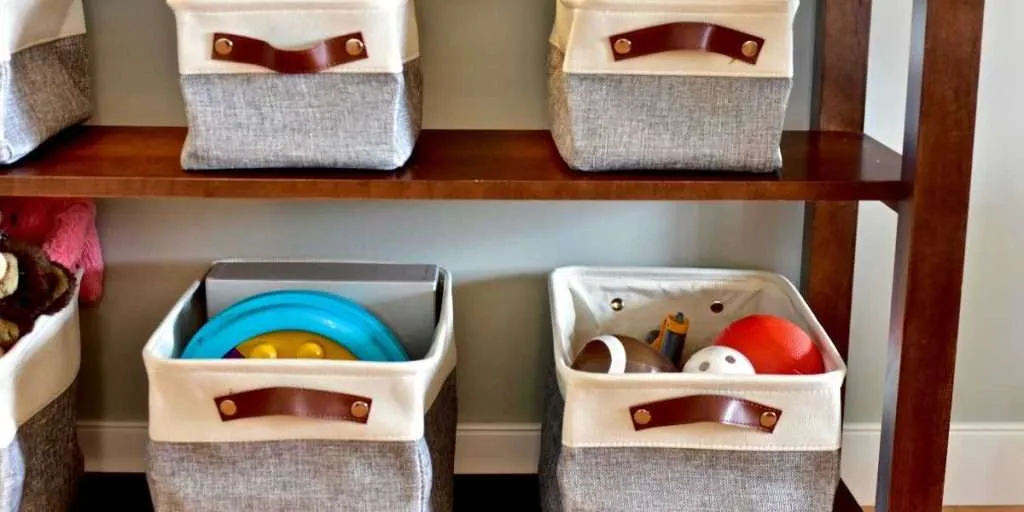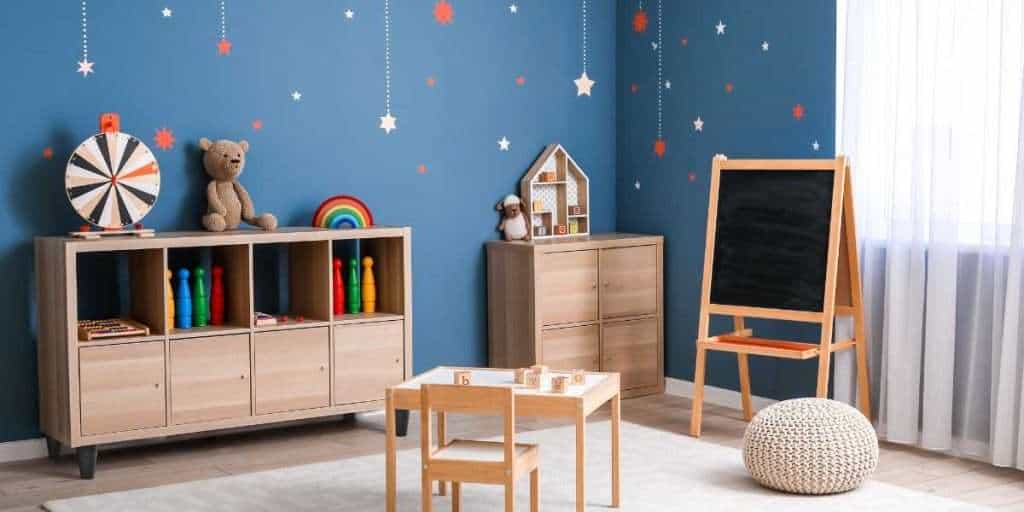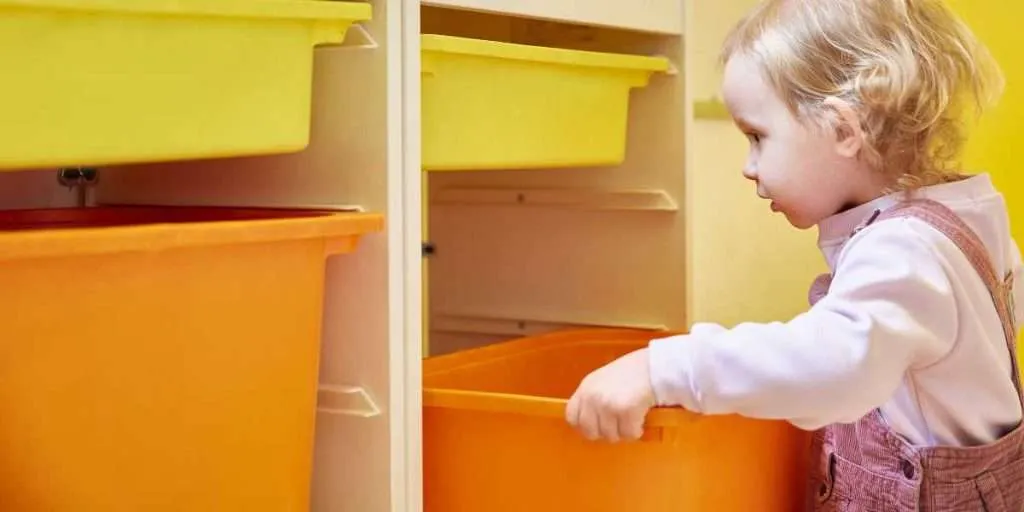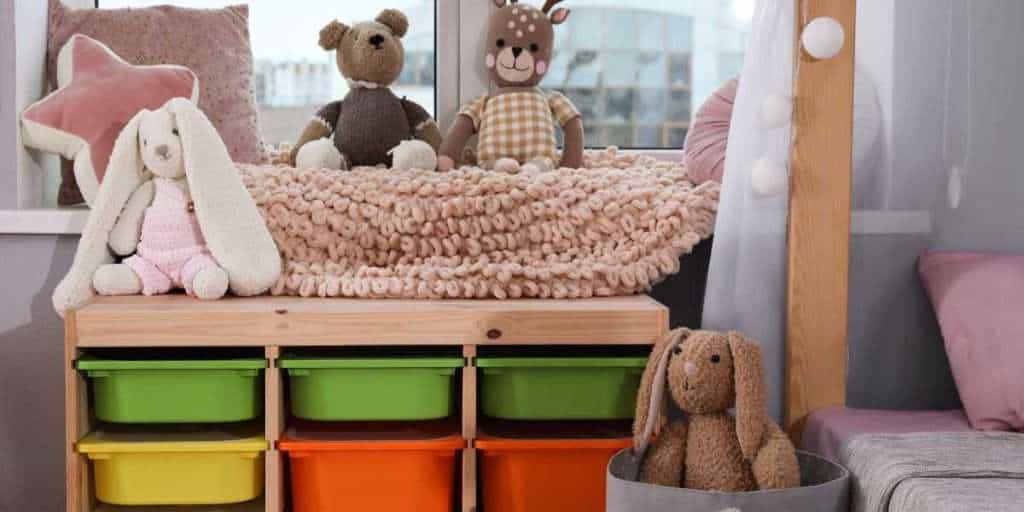I’m a parent who’s turned the daunting task of playroom organization into an achievable routine.
I’ve learned that with the right storage, rules, and a bit of help from the kids, we can transform a chaotic space into a fun, learning-friendly environment.
I want to share my nine foolproof tips with you, to help you reclaim the joy in your playroom.
Together, let’s cultivate creativity, independence, and responsibility in our children.
Key Takeaways
- Choose a storage system that fits your space and style
- Implement a toy rotation to keep kids entertained and prevent boredom
- Teach kids to clean up their toys and contribute to the organization
- Utilize labels to identify the contents of storage bins and baskets
Best Toy Storage Solutions
Quick Summary
| Step | Instructions |
|---|---|
| 1. Declutter | Start by sorting through all the toys. Donate or toss any broken toys or those no longer in use. |
| 2. Categorize Toys | Group toys by type: arts and crafts, building blocks, dolls, cars, books, etc. This helps in deciding storage solutions. |
| 3. Use Clear Storage Bins | Clear bins allow children to easily see their toys. Label each bin with a picture or name of the toy category for easy identification. |
| 4. Install Shelves | Use shelves to store books, board games, and larger toys. Open shelving allows for easy access. |
| 5. Use Vertical Space | Hang organizers, pegboards, or mesh nets for stuffed animals. This utilizes wall space and keeps the floor clear. |
| 6. Rotate Toys | Keep a set number of toys out, and store the rest away. Rotate them every few weeks to keep the playroom fresh and engaging. |
| 7. Designate Zones | Create specific areas for different activities, like a reading nook, art area, or building corner. |
| 8. Use Larger Bins for Bulky Toys | Items like trucks, dolls, or playsets can go in larger containers or baskets. |
| 9. Store Art Supplies Separately | Use caddies or organizers with compartments to store crayons, markers, glue, and other craft supplies. |
| 10. Incorporate Soft Storage | Bean bags with storage or ottomans can hold toys and also serve as seating. |
| 11. Label Everything | Especially if you’re using non-clear containers. This helps children know where to put things back. |
| 12. Make Cleaning Up a Game | Encourage children to clean up by making it fun, like seeing who can put away toys the fastest. |
| 13. Regular Maintenance | Periodically revisit the organization system, declutter, and adjust as children grow and their toy preferences change. |
Understanding the Importance of Storage Systems and Bins
Why don’t we delve into why it’s so critical to have a good storage system and bins in place for an organized and clutter-free playroom?
As I’ve discovered, efficient storage is the backbone of any well-kept playroom. Creative storage solutions for small playrooms become a lifesaver, especially when space is limited. I’ve turned to DIY organization hacks for playroom storage, using multipurpose furniture, clear bins for easy identification, and tiered baskets for maximizing vertical space.
The right storage system not only contains the clutter but also adds a pleasing aesthetic element to the room. It’s also essential to involve the little ones in maintaining this system, fostering a sense of responsibility and orderliness.

Importance of Keeping Messy Toys Out of Reach
I’ve discovered that the secret to keeping a playroom neat often hinges on the thoughtful positioning of toys, particularly by placing the messier ones for creative play beyond easy reach. Not that there is not a place for messy play, it is an important part of child development.
It’s about safety precautions as much as it’s about keeping the place organized. For instance, messy toys like paints, playdough, and science kits, which require supervision, should be stored on higher shelves in storage containers or behind closed doors to prevent accidents.
Organizing toys by age is a clever move. Toys suitable for older children can be kept out of reach from the younger ones in toy bins higher up. Not only does it keep the little ones safe from choking hazards, but it also makes for a toy clutter-free playroom.
Best Toy Storage Options
Honey-Can-Do Kids Toy Organizer and Storage Bins
Transform your child’s playroom into an oasis of order with the Honey-Can-Do Kids Toy Organizer!
With 12 vibrant and varying-sized bins, this organizer effortlessly categorizes toys, ensuring each prized possession has its rightful place.
The bright-colored bins not only add a splash of fun but also teach kids the essence of organization and clean-up.
Crafted from sturdy wood, adorned with matching metal rods, and finished in a timeless brown, this wall-mountable unit is both durable and chic.
Plus, its stain-resistant surfaces make tidying a breeze.
Go beyond mere storage; instill lifelong organizational habits while keeping playtime essentials within arm’s reach.
Humble Crew Inspire Toy Organizer
Introducing the Humble Crew Inspire Toy Organizer – the epitome of style meeting functionality!
Crafted in a neutral grey with contrasting white bins, this organizer seamlessly fits into any décor, be it a playroom, nursery, or living room.
The nine interchangeable plastic bins – both standard and large-sized – are not only BPA and phthalate free but also easily removable, making playtime tidy-up a breeze.
The organizer’s sturdy wood frame, bolstered by steel dowels, ensures durability, while the stabilizing braces add an extra layer of safety.
With an added top shelf for bonus storage, this unit promises to make toy organization not just practical, but also an aesthetic delight.
Dive into a clutter-free world where toys have their own designated spots and children are inspired to organize!
6 Quart Clear Latch Storage Box
These clear boxes, accented with sleek black handles and latches, are the perfect solution for storing and categorizing toys, craft items, and more.
With a see-through base, it’s a breeze to identify contents at a glance, saving precious playtime minutes.
Not only are the boxes equipped with sturdy black latches ensuring everything stays in place, but their design also allows for effortless stacking, maximizing space and decluttering areas.
The added handle ensures easy portability, while the ample size accommodates a range of items.
Dive into a world where every toy has its home, and transparency meets style!
The Concept of Toy Rotation
I’m also rotating toys on a weekly basis, so the kids always have ‘new toys’ to play with and it keeps clutter to a minimum.
The benefits of toy rotation are multifold. It not only helps to keep the play area tidy but also stimulates their curiosity and creativity. The trick is to store a portion of toys out of sight and reintroduce them periodically. This simple strategy maintains their interest in old toys, making them feel ‘new’ again.
In terms of tips for implementing a toy rotation schedule, I’d suggest starting small, maybe with two sets of toys. Rotate them every week and gradually increase the number of sets available in the toy box.
It’s a practical, cost-effective method to manage toy chaos and keep the little ones engaged. Remember too many toys can be bad for a child, read out guide to how many toys a child needs.
The Need for Setting Rules in the Playroom
An organized playroom is more than just a space to store toys; it’s a child’s haven for creativity, learning, and fun. However, without structure and guidelines, this haven can quickly transform into chaos. Setting rules in the playroom is crucial for several reasons:
1. Safety First
Above all, rules ensure safety. By setting guidelines on how toys should be used and stored, potential hazards like tripping over scattered toys or mishandling can be minimized.
2. Instilling Responsibility
By setting rules, children learn to take responsibility for their belongings. They understand the importance of putting toys back after playing, ensuring that items are not lost or damaged.
3. Fostering Independence
When children know where each toy belongs and the rules for each activity, they can play more independently. They don’t constantly need adult intervention to find things or decide what’s allowed.
4. Encouraging Respect for Shared Spaces
Playrooms are often shared spaces among siblings or even friends during playdates. Rules help children learn to respect shared areas and the belongings of others, fostering harmonious play.
5. Reducing Overwhelm
A cluttered space can be overwhelming for children (and adults!). When there’s a system in place, and children know the rules, it’s easier to maintain a tidy environment, making playtime more enjoyable and less stressful.
6. Teaching Time Management
By incorporating time-based rules, such as cleaning up 10 minutes before dinner or rotating toys weekly, children begin to grasp the concept of time management.
7. Preparing for the World Outside
The playroom can be a microcosm of the world outside. By learning to follow rules in this controlled environment, children are better prepared to understand societal norms and expectations as they venture outside their homes.

Playroom Organization Ideas
| Idea | Description |
|---|---|
| Theme-Based Zones | Designate areas based on themes: art corner, reading nook, dress-up zone, etc. This helps children know where to find and store specific toys. |
| Pegboards | Install pegboards on walls. They are versatile and can hold baskets, bins, or hooks to organize a variety of toys and craft supplies. |
| Hanging Baskets | Use hanging baskets, especially for stuffed animals or lightweight toys. It’s visually appealing and saves floor space. |
| Rolling Storage | Use carts with wheels for toys or art supplies. They can be easily moved around the playroom or to other rooms. |
| Magnetic Strips | Install them to organize toy cars, magnetic letters, or any toy with a magnetic component. |
| Book Ledges | Instead of traditional bookshelves, use ledges or rain gutters to display books with their covers facing out. It’s visually appealing and encourages reading. |
| Chalkboard Walls | Dedicate a wall or part of it as a chalkboard. It’s a space for art and can also be used to jot down organization rules or toy categories. |
| Toy Rotation System | Use labeled bins to rotate toys every few weeks. Store non-displayed toys out of sight and switch them out to keep the playroom fresh. |
| Under-Seating Storage | Use benches or ottomans that open to store toys. This provides both seating and storage. |
| Clear Shoe Organizers | Hang them behind doors to store small toys, action figures, or craft supplies in the clear pockets. |
| Label Everything | Use pictures and words to label bins and shelves. This aids in easy cleanup and teaches kids organization skills. |
| Art Display Area | Dedicate a wall or a section for displaying children’s artwork. Use clipboards, frames, or wire with clips. |
| DIY Play Tables | Convert coffee tables or dining tables into play tables by adding storage bins underneath and painting the surface with chalkboard paint or attaching a LEGO baseplate. |
| Color Coding | Assign a color for each child or toy category. Use colored bins, baskets, or labels. This makes it easy to identify and sort toys. |
These ideas can be adapted based on the size of the playroom, the age of the children, and individual preferences. The key is to create a system that children can understand and follow, making playtime more enjoyable and cleanup easier.
Role of Teaching Kids to Help in Playroom Organization
Empowering children to take an active role in organizing their playroom not only eases the workload for parents but also instills essential life skills in the young ones. Here’s how you can guide them:
1. Lead by Example
Children often emulate what they see. Start by organizing the playroom together, demonstrating how toy organization works, use storage bins, and maintain order. Your actions will serve as a practical lesson.
2. Simplify the Process
Break down the organization process into simple, manageable tasks. Instead of instructing them to “clean the playroom,” specify tasks like “put all the LEGO pieces in the lego storage bin, put art materials in the art display bin”
3. Use Clear, Labeled Storage
Opt for transparent storage bins or boxes or storing toys, so children can easily see what’s inside. Labeling bins with pictures or words (for older kids) can also help them identify where each toy belongs.
4. Create a Routine
Establish a regular cleaning routine, such as tidying up before lunch or bedtime. Consistency helps children internalize the importance of maintaining order. Just 5 mins at the end of play to declutter toys makes a huge difference in the long run.
5. Make it Fun
Turn cleaning and organizing into a game. Whether it’s a race against time or a challenge to see who can sort toys the fastest, adding an element of fun can motivate kids.
6. Empower Decision Making
Allow children to make decisions about what toys to keep and which to donate. This teaches them about decluttering and the value of generosity.
7. Celebrate Their Efforts
Recognize and applaud their efforts in maintaining an organized playroom. Positive reinforcement, such as praises or reward charts, can motivate continued participation.
8. Teach Maintenance
Once the playroom is organized, emphasize the importance of maintaining it. Teach them the “one out, one in” rule, where they must put away one toy before taking out another.
9. Involve Them in Purchases
When buying new storage solutions or toys, involve them in the decision-making process. This gives them a sense of ownership and responsibility towards the items.
10. Continual Learning
As children grow, their organizational needs will change. Regularly revisit the playroom setup, discuss what’s working and what’s not, and adapt accordingly.

Using Labels for Better Organization
1. Choose Clear and Legible Fonts: Ensure that the text on labels is easily readable by everyone, including children or individuals with visual impairments.
2. Use Icons or Pictures: For younger children or non-native speakers, consider using pictures or icons alongside text for better comprehension.
3. Durable Labels: Especially for areas prone to wear and tear or moisture, use laminated labels or those made of durable materials.
4. Color-Coding: Enhance organization by using color-coded labels, especially in diverse environments. Each color can represent a category or priority.
5. Update Regularly: As your organizational needs evolve, ensure your labels stay relevant. Regularly update them to match the contents.
6. Invest in a Label Maker: For a professional touch and ease of updating, consider investing in a label maker, which allows customization and uniformity.
7. Involve Everyone: If the space is shared, involve everyone in the labeling process. This fosters a sense of ownership and understanding of the system in place.
Involving Kids in the Playroom Design Process
Surprisingly, involving kids in the playroom design process can significantly boost their sense of ownership and enjoyment in the space. By incorporating their ideas, we’re not just creating a fun area, but also a learning environment that sparks their interest.
- Playroom design ideas for different age groups: I’ve found that modular furniture works best as it grows with the child. A toddler might love a puppet theater, while an older child may prefer a reading nook.
- Incorporating learning and educational elements: I ensure the space has a balance between fun and educational toys. For instance, a world map wall decal or a science experiment kit.
- Involving kids in design: I let them choose the color scheme and theme, and we brainstorm together on the room layout.

Frequently Asked Questions On Keeping Your Playroom organized
What Are Some Creative DIY Storage Solutions for a Playroom?
I’ve turned old wooden crates into bookshelves and storage bins. Dual purpose furniture, like ottomans with hidden storage, are also a lifesaver. Don’t overlook the potential of recycled materials to declutter and beautify your playroom.
How Should I Handle Organizing Toys With Many Small Pieces, Like Puzzles or LEGO Sets?
Dealing with tiny toy pieces feels like tackling a mountain! I sort by theme, keeping puzzles or Legos together. Puzzle storage techniques like ziplock bags or dedicated bins are lifesavers. It keeps everything neat and orderly.
Are There Specific Types of Toys That Are Better for Promoting Independent Play and Reducing Mess?
Absolutely! Toys promoting independent play and less mess include sensory play items like kinetic sand or play dough. Toy rotation benefits include keeping interest high and mess low by limiting the toys available.
What Strategies Can I Use to Encourage My Children to Follow the Playroom Rules Consistently?
I’m implementing a reward system to motivate my kids to follow playroom rules. Establishing a consistent routine, we’re seeing progress. We celebrate small victories, reinforcing the importance of keeping our playroom neat and organized.
How Can I Effectively Involve My Children in the Process of Decluttering Their Toys Without Causing Distress or Arguments?
I use reward system ideas to motivate my kids during decluttering. We discuss letting go, building emotional intelligence. It’s not always easy, but it’s worth it to create a tidy, joyful playroom together.








